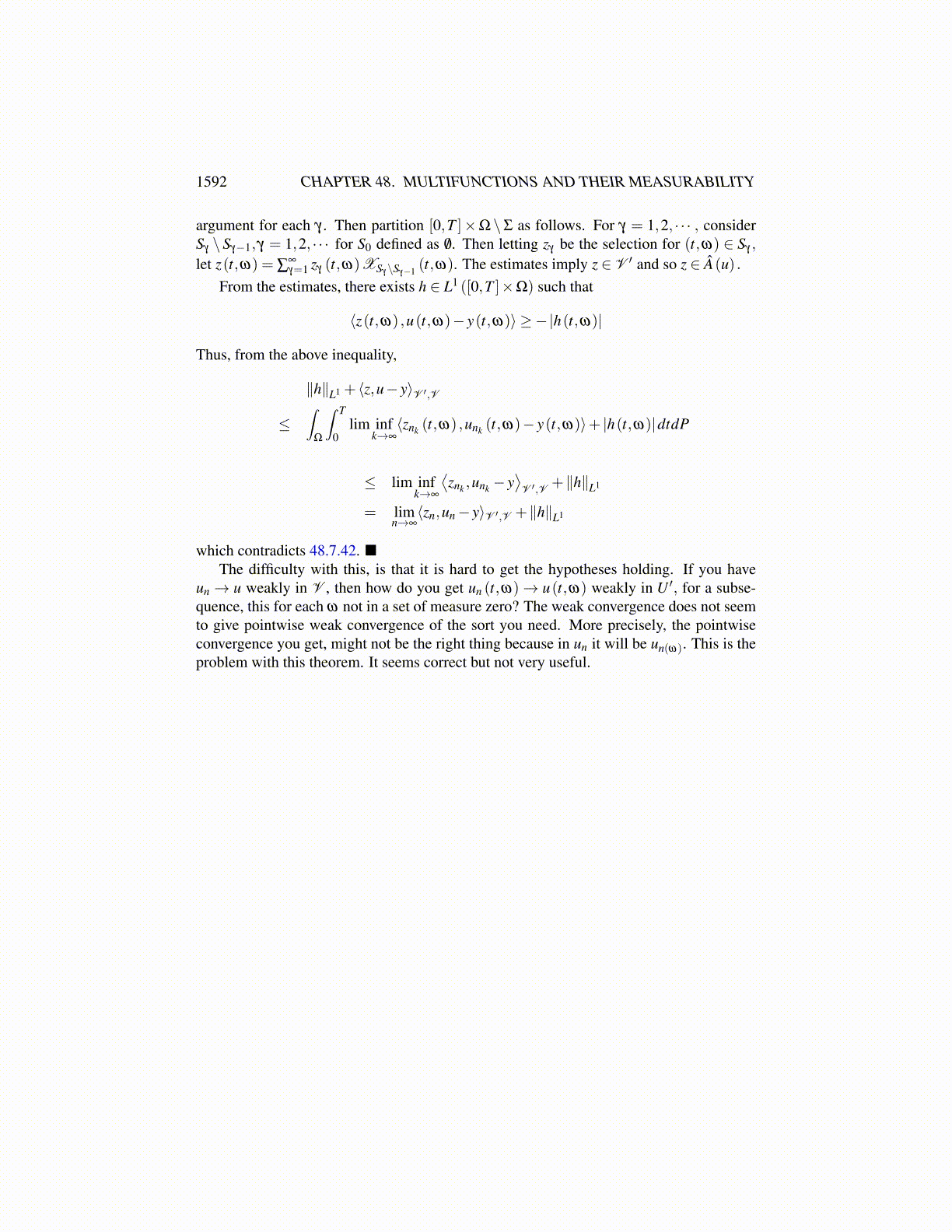
1592 CHAPTER 48. MULTIFUNCTIONS AND THEIR MEASURABILITY
such that for a.e.(t,ω)
α (t,ω) ≡ lim infk→∞⟨znk (t,ω) ,unk (t,ω)− y(t,ω)⟩
= lim infk→∞⟨znk (t,ω) ,u(t,ω)− y(t,ω)⟩ ≥ ⟨wt,ω ,u(t,ω)− y(t,ω)⟩.
Then on the exceptional set, let α (t,ω)≡ ∞, and consider the set
F (t,ω)≡ {w ∈ A(u(t,ω) , t,ω) : ⟨w,u(t,ω)− y(t,ω)⟩ ≤ α (t,ω)} ,
which then satisfies F (t,ω) ̸= /0. Now F (t,ω) is closed and convex in V ′.Claim : (t,x)→ F (t,ω) has a measurable selection off a set of measure zero.Proof of claim: Letting B(0,C (t,ω)) contain A(u(t,ω) , t,ω) , we can assume
(t,ω)→C (t,ω)
is P measurable by using the estimates and the measurability of u. For γ ∈ N, let Sγ ≡{(t,ω) : C (t,ω)< γ} . If it is shown that F has a measurable selection on Sγ , then it followsthat it has a measurable selection. Thus in what follows, assume that (t,ω) ∈ Sγ .
Define
G(t,ω)≡{
w : ⟨w,u(t,ω)− y(t,ω)⟩< α (t,ω)+1n
, (t,ω) /∈ Σ
}∩B(0,γ)
Thus, it was shown above that this G(t,ω) ̸= /0 at least for large enough γ . For U open,
G− (U)≡{
(t,ω) ∈ Sγ : for some w ∈U ∩B(0,γ) ,⟨w,u(t,ω)− y(t,ω)⟩< α (t,ω)+ 1
n
}(*)
Let{
w j}
be a dense subset of U ∩B(0,γ). This is possible because V ′ is separable. Theexpression in ∗ equals
∪∞k=1
{(t,ω) ∈ Sγ : ⟨wk,u(t,ω)− y(t,ω)⟩< α (t,ω)+
1n
}which is measurable. Thus G is a measurable multifunction.
Since (t,ω)→ G(t,ω) is measurable, there is a sequence {wn (t,ω)} of measurablefunctions such that ∪∞
n=1wn (t,ω) equals
G(t,ω) =
{w : ⟨w,u(t,ω)− y(t,ω)⟩ ≤ α (t,ω)+
1n
, t /∈ Σ
}∩B(0,γ)
As shown above, there exists wt,ω in A(u(t,ω) , t,ω) as well as G(t,ω) . Thus there isa sequence of wr (t,ω) converging to wt,ω . Of course r will need to depend on t,ω . Since(t,ω)→ A(u(t,ω) , t,ω) is a measurable multifunction, it has a countable subset of Pmeasurable functions {zk (t,ω)} which is dense in A(u(t,ω) , t,ω). Let
Uk (t,ω)≡ ∪mB(
zm (t,ω) ,1k
)⊆ A(u(t,ω) , t,ω)+B
(0,
2k
)